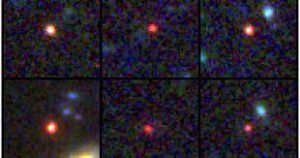6 Monster Galaxies Discovered:

The James Webb Space Telescope (JWST) has discovered six Monster galaxies, formed roughly 500-700 million years after the Big Bang, according to a Study.
- Researchers spotted the six monster galaxies using the Cosmic Evolution Early 44 Release Science programme of JWST.
- The programme studies the formation of the earliest galaxies when the universe was less than 5% of its current age.
- Researchers turned the telescope to a patch of the sky close to the Big Dipper, which appears to harbor a group of stars that form a pattern in the night sky. The Hubble space telescope first observed this region in the 1990s.
- The Big Dipper is an asterism of stars, in the constellation Ursa Major (also known as the Great Bear).
- It consists of seven bright stars, four forming a rectangular “bowl” shape and three forming a “handle”. It is often used as a navigational tool, a reference point for stargazing, and as a symbol in popular culture.
- Despite having the same mass as the Milky Way, one of the galaxies is 30 times smaller.
- This indicates the presence of large and mature but remarkably compact galaxies teeming with stars far sooner than scientists had considered possible.
- The telescope reveals that six large, mature galaxies are as old as the Milky Way and exist around 540-770 million years after the Big Bang.
- The universe was roughly 3 % of its current age at the time.
- These galaxies challenge our current understanding of galaxy formation as they should not have existed so early in their life.




